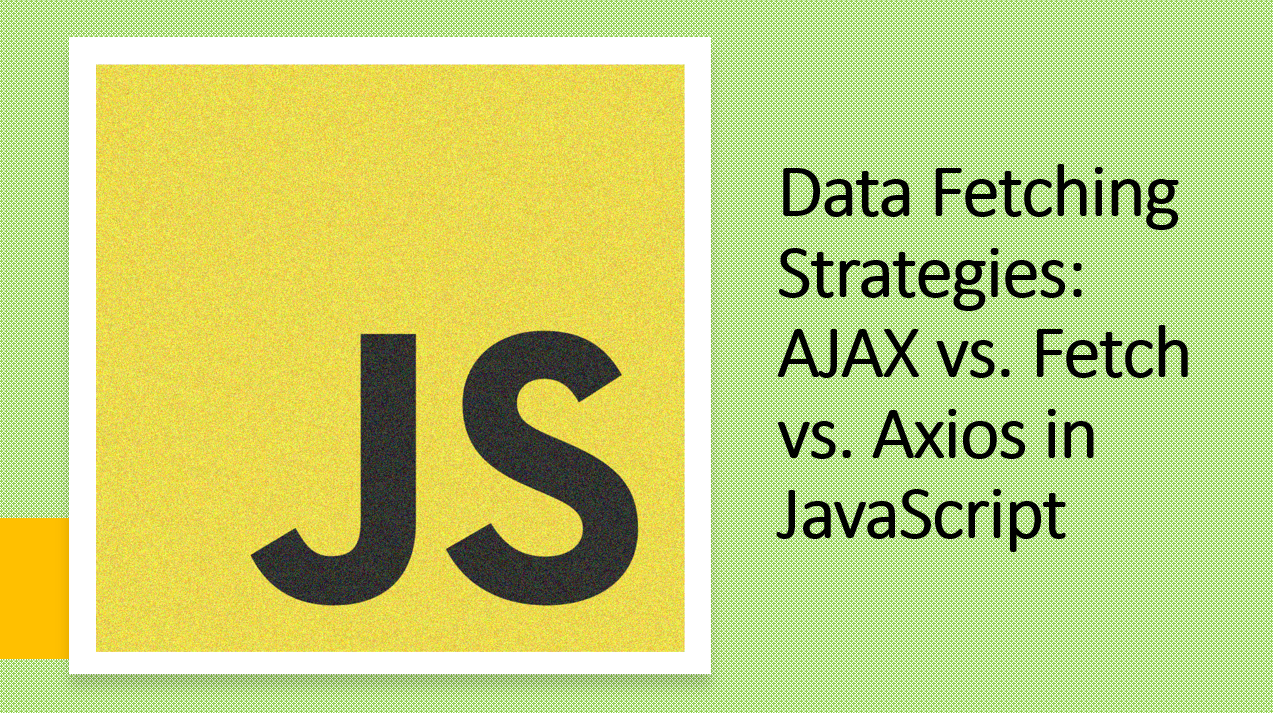
Introduction
Fetching data from remote servers is a common task in web development. In JavaScript, there are several approaches to accomplish this, with AJAX, Fetch API, and third-party libraries like Axios being popular choices.
In this guide, we'll explore these data fetching strategies, their features, and when to use each one.
Let's get started!
1. AJAX (Asynchronous JavaScript and XML)
AJAX is a traditional approach for making asynchronous requests to a server and fetching data without reloading the entire page.
AJAX is a browser technology that uses a combination of:
- HTML and CSS for presentation
- JavaScript for dynamic behavior
- XML for data interchange
Here's an example of an AJAX request using the XMLHttpRequest object:
const xhr = new XMLHttpRequest();
xhr.open('GET', 'https://api.example.com/data', true);
xhr.onreadystatechange = function() {
if (xhr.readyState === 4 && xhr.status === 200) {
const data = JSON.parse(xhr.responseText);
console.log(data);
}
};
xhr.send();
In the example above:
We create a new
XMLHttpRequestobject and use theopen()method to initialize a request.The
open()method accepts three arguments:- The HTTP method (GET, POST, PUT, DELETE, etc.)
- The URL of the resource to be fetched
- A boolean value indicating whether the request should be asynchronous or not
We use the
onreadystatechangeevent handler to listen for changes in the request state.When the request state is
4(request finished and response is ready) and the status code is200(OK), we parse the response text into a JavaScript object and log it to the console.Finally, we call the
send()method to send the request to the server.
2. Fetch API
The Fetch API is a modern replacement for the XMLHttpRequest object. It provides a simple, powerful, and flexible interface for fetching resources from the server.
Here's an example of a Fetch request:
fetch('https://api.example.com/data')
.then(response => response.json())
.then(data => console.log(data))
.catch(error => console.log(error));
In the example above:
- We use the
fetch()method to make a GET request to the specified URL. - The
fetch()method returns aPromiseobject that resolves to aResponseobject. - We use the
json()method to parse the response body into a JavaScript object. - We use the
then()method to handle the resolvedPromiseobject. - We use the
catch()method to handle any errors that may occur.
3. Axios (Third-party library)
Axios is a popular third-party library that simplifies HTTP requests and handling responses. It works both in browsers and Node.js.
Learn more about Axios here.
Here's an example of an Axios request:
axios
.get('https://api.example.com/data')
.then(response => console.log(response.data))
.catch(error => console.log(error));
In the example above:
- We use the
get()method to make a GET request to the specified URL. - The
get()method returns aPromiseobject that resolves to aResponseobject. - We use the
then()method to handle the resolvedPromiseobject. - Then we use the
catch()method to handle any errors that may occur.
Features and Considerations
AJAX
- Widely supported, even in older browsers.
- Requires more boilerplate code for handling responses and errors.
- Might need additional libraries for Promise-based handling.
Fetch API
- Modern and built into modern browsers.
- Returns Promises, making async/await syntax easy to use.
- Supports different types of data, like JSON, text, and more.
Axios
- Third-party library with built-in Promise support.
- Handles request and response interception, making error handling more centralized.
- Handles JSON parsing by default.
When to Use Each Approach
Use
AJAXif you need to support older browsers or if you prefer not to use third-party libraries.Use the
Fetch APIif you want to leverage modern browser features and Promises. It's a great choice for most data fetching needs.Use
Axiosif you want a comprehensive solution with enhanced features like error handling, request/response interception, and a more consistent API.
Conclusion
When it comes to data fetching strategies in JavaScript, you have options. AJAX, Fetch API, and Axios each offer unique features and benefits. Choose the strategy that aligns with your project's requirements, browser support, and your preferred coding style. Understanding these strategies will equip you with the tools needed to efficiently fetch data and build responsive web applications.
We hope you found this guide helpful.
Happy coding! 🙌